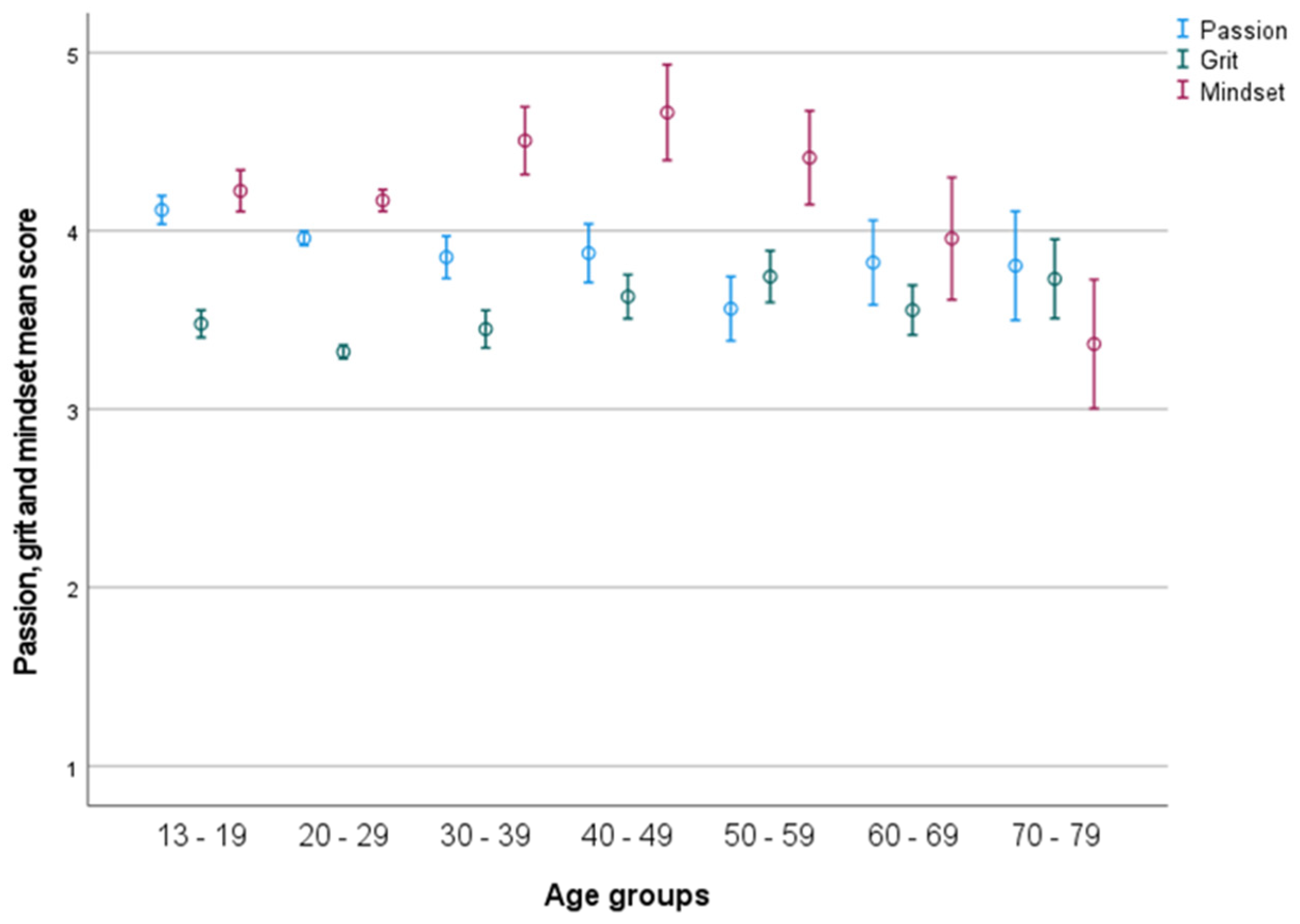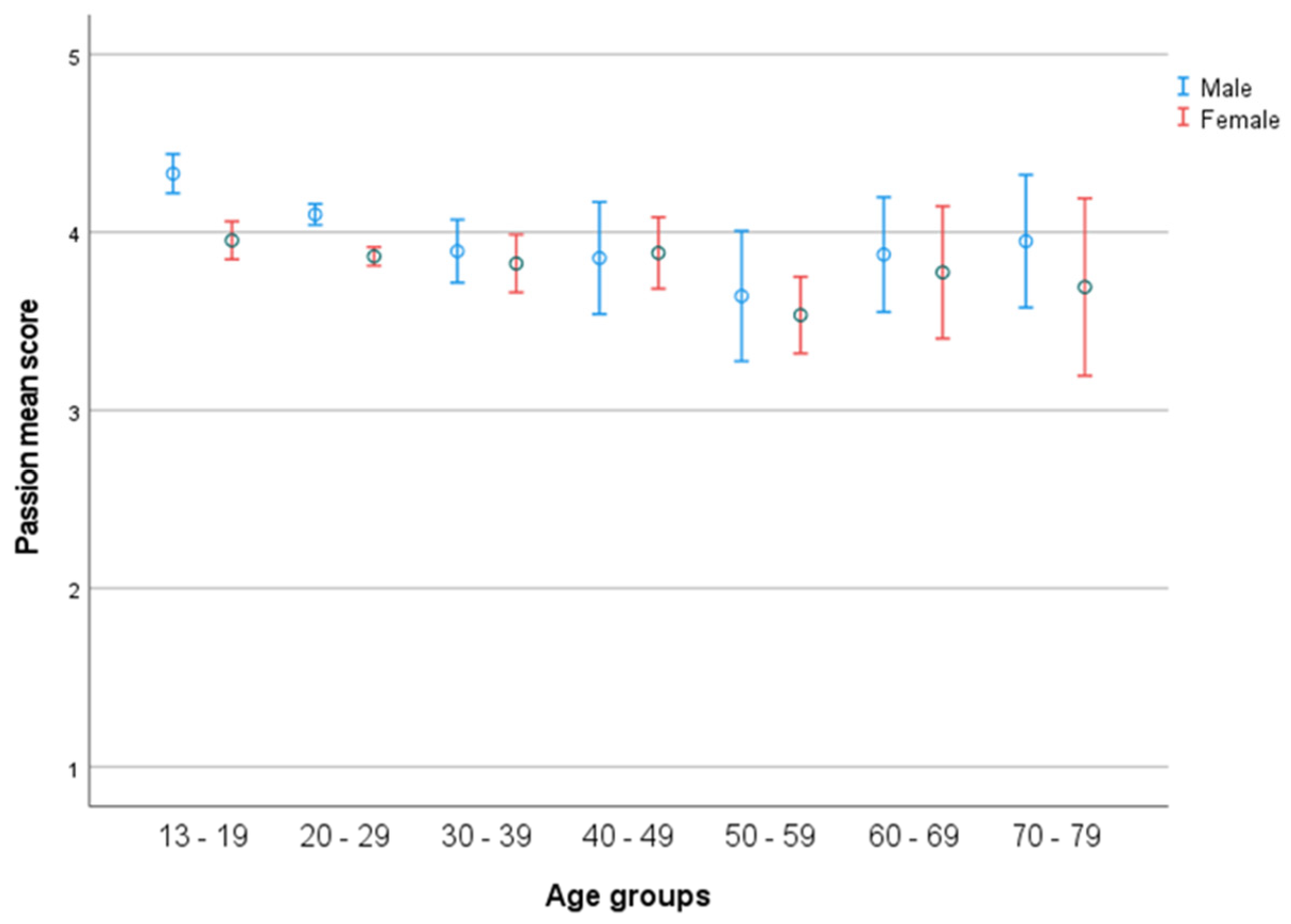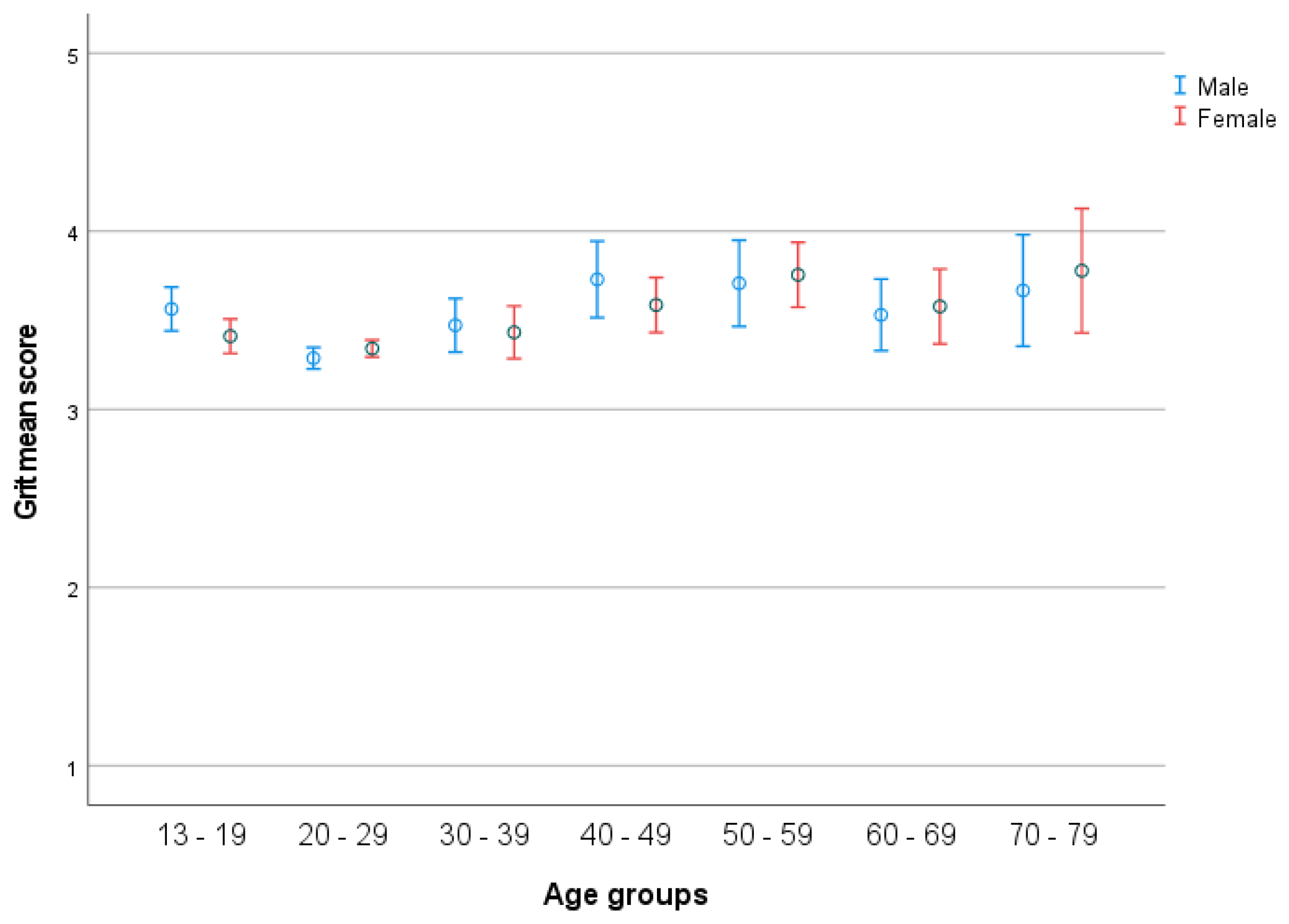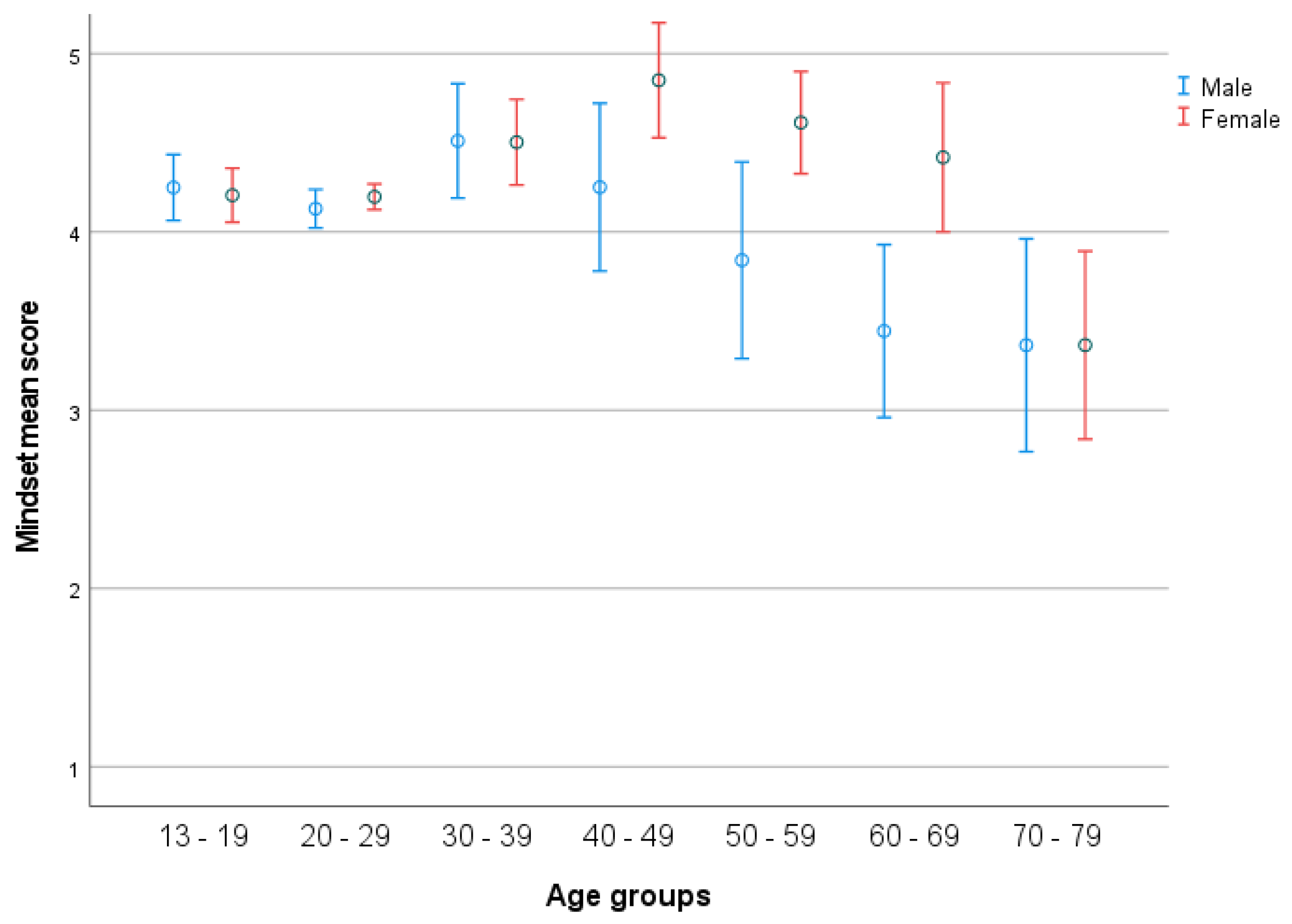Motivational Factors Are Varying across Age Groups and Gender
Abstract
:1. Introduction
2. Method
2.1. Participants
2.2. Measurements
2.2.1. Passion
2.2.2. Grit
2.2.3. Mindset
2.3. Procedure
2.4. Data Analysis
3. Results
3.1. Demographic Differences
3.2. Passion
3.3. Grit
3.4. Mindset
4. Discussion
4.1. Passion
4.2. Grit
4.3. Mindset
4.4. Limitations and Future Research
5. Conclusions
Author Contributions
Funding
Institutional Review Board Statement
Informed Consent Statement
Data Availability Statement
Conflicts of Interest
References
- Ericsson, K.A.; Prietula, M.J.E.T.; Cokely, E.T. The making of an expert. Harv. Bus. Rev. 2007, 87, 115–121. [Google Scholar]
- Vallerand, R.J. On passion for life activities: The Dualistic Model of Passion. In Advances in Experimental Social Psychology; Zanna, M.P., Ed.; Academic Press: New York, NY, USA, 2010; pp. 97–193. [Google Scholar]
- Ericsson, A.; Pool, R. Peak: Secrets from the New Science of Expertise; Houghton Mifflin Harcourt: Boston, MA, USA, 2016. [Google Scholar]
- Duckworth, A.G. The Power of Passion and Perseverance; Scribner Book Company: New York, NY, USA, 2016. [Google Scholar]
- Dweck, C.S. Mindset. Changing the Way You Think to Fulfil Your Potential; Little, Brown Book Group: Boston, MA, USA, 2017. [Google Scholar]
- Yeager, D.S.; Hanselman, P.; Walton, G.M.; Murray, J.S.; Crosnoe, R.; Muller, C.; Tipton, E.; Schneider, B.; Hulleman, C.S.; Hinojosa, C.P.; et al. A national experiment reveals where a growth mindset improves achievement. Nature 2019, 573, 364–369. [Google Scholar] [CrossRef] [PubMed] [Green Version]
- Sigmundsson, H.; Clemente, F.; Loftesnes, J.M. Passion, grit and mindset in football players. New Ideas Psychol. 2020, 59, 100797. [Google Scholar] [CrossRef]
- Sigmundsson, H.; Haga, M.; Hermundsdottir, F. The Passion scale: Aspects of reliability and validity of a new 8-item scale assessing passion. New Ideas Psychol. 2020, 56, 100745. [Google Scholar] [CrossRef]
- Sigmundsson, H.; Haga, M.; Hermundsdottir, F. Passion, grit and mindset in young adults: Exploring the relationship and gender differences. New Ideas Psychol. 2020, 59, 100795. [Google Scholar] [CrossRef]
- Datu, J.A.D.; Yang, L.; Mateo, N.J. Are gritty students academically engaged in Math and Science? Sch. Psychol. 2021, 36, 190–195. [Google Scholar] [CrossRef]
- Bonneville-Roussy, A.; Vallerand, R.J. Passion at the heart of musicians’ well-being. Psychol. Music 2018, 48, 266–282. [Google Scholar] [CrossRef] [Green Version]
- Jachimowicz, J.M.; Wihler, A.; Bailey, E.R.; Galinsky, A.D. Why grit requires perseverance and passion to positively predict performance. Proc. Natl. Acad. Sci. USA 2018, 115, 9980–9985. [Google Scholar] [CrossRef] [Green Version]
- Ruiz-Alfonso, Z.; Leon, J. The role of passion in education: A systematic review. Educ. Res. Rev. 2016, 19, 173–188. [Google Scholar] [CrossRef]
- Duckworth, A.L.; Kirby, T.A.; Tsukayama, E.; Berstein, H.; Anders Ericsson, K. Deliberate Practice Spells Success: Why Grittier Competitors Triumph at the National Spelling Bee. Soc. Psychol. Personal. Sci. 2011, 2, 174–181. [Google Scholar] [CrossRef] [Green Version]
- Vallerand, R.J.; Blanchard, C.; Mageau, G.A.; Koestner, R.; Ratelle, C.; Léonard, M.; Gagné, M.; Marsolais, J. Les passions de l’ame: On obsessive and harmonious passion. J. Pers. Soc. Psychol. 2003, 85, 756–767. [Google Scholar] [CrossRef] [Green Version]
- Sigmundsson, H.; Guðnason, S.; Jóhannsdóttir, S. Passion, grit and mindset: Exploring gender differences. New Ideas Psychol. 2021, 63, 100878. [Google Scholar] [CrossRef]
- Duckworth, A.L.; Peterson, C.; Matthews, M.D.; Kelly, D.R. Grit: Perseverance and passion for long-term goals. J. Pers. Soc. Psychol. 2007, 92, 1087–1101. [Google Scholar] [CrossRef]
- Duckworth, L.A.; Gross, J.J. Self-Control and Grit: Related but Separable Determinants of Success. Curr. Dir. Psychol. Sci. 2014, 23, 319–325. [Google Scholar] [CrossRef] [Green Version]
- Duckworth, A.L.; Quinn, P.D. Development and validation of the short grit scale (Grit S). J. Pers. Assess. 2009, 91, 166–174. [Google Scholar] [CrossRef]
- Cassidy, S. Resilience Building in Students: The role of academic Self-Efficacy. Front. Psychol. 2015, 6, 1781. [Google Scholar] [CrossRef] [Green Version]
- Ledford, A.; Luning, C.R.; Miles, P.; Dixon, D.; Lynch, S. Investigating the Measurement of, and Interrelationship Between Resilience, Hardiness, Grit in a Population of Navy SEAL Candidates. Am. J. Manag. 2021, 21, 82–102. [Google Scholar]
- Park, D.; Tsukayama, E.; Yu, A.; Duckworth, A.L. The development of grit and growth mindset during adolescence. J. Exp. Child Psychol. 2020, 198, 104889. [Google Scholar] [CrossRef]
- Credé, M.; Tynan, M.C.; Harms, P.D. Much ado about grit: A meta-analytic synthesis of the grit literature. J. Personal. Soc. Psychol. 2017, 113, 492–511. [Google Scholar] [CrossRef]
- Credé, M. What Shall We Do About Grit? A Critical Review of What We Know and What We Don’t Know. Educ. Res. 2018, 47, 606–611. [Google Scholar] [CrossRef] [Green Version]
- Kannangara, C.S.; Allen, R.E.; Waugh, G.; Nahar, N.; Khan, S.Z.N.; Rogerson, S.; Carson, J. All that glitters is not grit: Three studies of grit in university students. Front. Psychol. 2018, 9, 1539. [Google Scholar] [CrossRef] [PubMed] [Green Version]
- McCrae, R.R.; Costa, P.T. Personality in Adulthood: A Five-Factor Theory Perspective; Guilford Press: New York, NY, USA, 2003. [Google Scholar]
- Schmidt, F.T.; Lechner, C.M.; Danner, D. New wine in an old bottle? A facet-level perspective on the added value of Grit over BFI–2 Conscientiousness. PLoS ONE 2020, 15, e0228969. [Google Scholar] [CrossRef] [PubMed]
- Ponnock, A.; Muenks, K.; Morell, M.; Yang, J.S.; Gladstone, J.R.; Wigfield, A. Grit and conscientiousness: Another jangle fallacy. J. Res. Personal. 2020, 89, 104021. [Google Scholar] [CrossRef]
- Schmidt, F.T.; Nagy, G.; Fleckenstein, J.; Möller, J.; Retelsdorf, J. Same Same, but Different? Relations between Facets of Conscientiousness and Grit. Eur. J. Pers. 2018, 32, 705–720. [Google Scholar] [CrossRef] [Green Version]
- Christensen, R.; Knezek, G. Comparative measures of grit, tenacity and perseverance. Int. J. Learn. Teach. Educ. Res. 2014, 8, 16–30. [Google Scholar]
- Dweck, C.S. Self-Theories. Their Role in Motivation, Personality and Development; Psychology Press: Philadelphia, PA, USA, 1999. [Google Scholar]
- Degol, J.L.; Wang, M.T.; Zhang, Y.; Allerton, J. Do growth mindsets in math benefit females? Identifying pathways between gender, mindset, and motivation. J. Youth Adolesc. 2018, 47, 976–990. [Google Scholar] [CrossRef]
- Dweck, C.S. What having a “growth mindset” actually means. Harv. Bus. Rev. 2016, 13, 213–226. [Google Scholar]
- Sisk, V.F.; Burgoyne, A.P.; Sun, J.; Butler, J.L.; Macnamara, B.N. To what extent and under which circumstances are growth mind-sets important to academic achievement? Two meta-analyses. Psychol. Sci. 2018, 29, 549–571. [Google Scholar] [CrossRef]
- Yan, V.X.; Thai, K.P.; Bjork, R.A. Habits and beliefs that guide self-regulated learning: Do they vary with mindset? J. Appl. Res. Mem. Cogn. 2014, 3, 140–152. [Google Scholar] [CrossRef]
- Spinath, B.; Spinath, F.M.; Riemann, R.; Angleitner, A. Implicit theories about perosnality and intelligence and their relationship to actual personality and intelligence. Personal. Individ. Differ. 2003, 35, 939–951. [Google Scholar] [CrossRef]
- Macnamara, B.N.; Rupani, N.S. The relationship between intelligence and mindset. Intelligence 2017, 64, 52–59. [Google Scholar] [CrossRef]
- Eskreis-Winkler, L.; Duckworth, A.L.; Shulman, E.P.; Beal, S. The grit effect: Predicting retention in the military, the workplace, school and marriage. Front. Psychol. 2014, 5, 36. [Google Scholar] [CrossRef] [Green Version]
- Kim, M.Y.; Lee, H.J. Does Grit Matter to Employees’ Quality of Work Life and Quality of Life? The Case of the Korean Public Sector. Public Pers. Manag. 2021, 51, 97–124. [Google Scholar] [CrossRef]
- Limeri, L.B.; Carter, N.T.; Choe, J.; Harper, H.G.; Martin, H.R.; Benton, A.; Dolan, E.L. Growing a growth mindset: Characterizing how and why undergraduate students’ mindsets change. Int. J. STEM Educ. 2020, 7, 35. [Google Scholar] [CrossRef]
- Sun, X.; Nancekivell, S.; Gelman, S.A.; Shah, P. Growth mindset and academic outcomes: A comparison of US and Chinese students. NPJ Sci. Learn. 2021, 6, 21. [Google Scholar] [CrossRef]
- Rhodes, E.; Giovannetti, T. Grit and successful aging in older adults. Aging Ment. Health 2021, 1–8. [Google Scholar] [CrossRef]
- Mehmetoglu, M.; Jakobsen, G.T. Applied Statistics Using STATA: A Guide for Social Sciences; Sage Publications: Thousand Oaks, CA, USA, 2017. [Google Scholar]
- Taylan, S.; Özkan, İ.; Çelik, G.K. The validity and reliability analysis of the Turkish version of the 8-item passion scale. New Ideas Psychol. 2020, 59, 100802. [Google Scholar] [CrossRef]
- Sending, V. Thinking Success, Behaving Successfully (Masteravhandling); The Artic University of Norway, UIT: Tromsø, Norway, 2014. [Google Scholar]
- Bråten, I.; Strømsø, H.I. Epistemological beliefs and implicit theories of intelligence as predictors of achievement goals. Contemp. Educ. Psychol. 2004, 29, 371–388. [Google Scholar] [CrossRef]
- Dweck, C.S.; Chiu, C.; Hong, Y. Implicit theories and their role in judgments and reactions: A word from two perspectives. Psychol. Inq. 1995, 6, 267–285. [Google Scholar] [CrossRef] [Green Version]
- Sala, G.; Gobet, F. Does far transfer exist? Negative evidence from chess, music, and working memory training. Curr. Dir. Psychol. Sci. 2017, 26, 515–520. [Google Scholar] [CrossRef]
- Datu, J.A.D.; McInerney, D.M.; Żemojtel-Piotrowska, M.; Hitokoto, H.; Datu, N. Is grittiness next to happiness? Examining the association of triarchic model of grit dimensions with well-being outcomes. J. Happiness Stud. 2021, 22, 981–1009. [Google Scholar] [CrossRef]
- Sigmundsson, H. Passion, grit and mindset in the ages 14 to 77: Exploring relationship and gender differences. New Ideas Psychol. 2020, 60, 100815. [Google Scholar] [CrossRef]
- Bronfenbrenner, U. Toward an experimental ecology of human development. Am. Psychol. 1977, 32, 513–531. [Google Scholar] [CrossRef]
- Swanson, J.L. Stability and change in vocational interests. In Vocational Interests: Meaning, Measurement, and Counseling Use; Savickas, M.L., Spokane, A.R., Eds.; Davies-Black Publishing: Palo Alto, CA, USA, 1999; pp. 135–158. [Google Scholar]
- Geary, D.C. Sexual selection and sex differences in mathematical abilities. Behav. Brain Sci. 1996, 19, 229–247. [Google Scholar] [CrossRef]
- Huttenlocher, J.W.; Haight, W.; Bryk, A.; Seltzer, M.; Lyons, T. Early vocabulary growth: Relation to language input and gender. Dev. Psychol. 1991, 27, 236–248. [Google Scholar] [CrossRef]
- Schlender, J.; Tan, K.; Wegmann, K. Gender Differences in Growth Mindset, Group Identity, and Social Skills. J. Undergrad. Soc. Work. Res. 2020, 4, 32–34. [Google Scholar]
- Greenberg, J.L.; Lewis, S.E.; Dodd, D.K. Overlapping addictions and self-esteem among college men and women. Addict. Behav. 1999, 22, 565–571. [Google Scholar] [CrossRef]
- Tang, J.; Dani, J.A. Dopamine enables in vivo synaptic plasticity associated with the addictive drug nicotine. Neuron 2009, 63, 673–682. [Google Scholar] [CrossRef] [Green Version]
- Fattore, L.; Melis, M.; Fadda, P.; Fratta, W. Sex differences in addictive disorders. Front. Neuroendocrinol. 2014, 35, 272–284. [Google Scholar] [CrossRef]
- Munro, C.A.; McCaul, M.E.; Wong, D.F.; Oswald, L.M.; Zhou, Y.; Brasic, J.; Kuwabara, H.; Kumar, A.; Alexander, M.; Ye, W.; et al. Sex differences in striatal dopamine release in healthy adults. Biol. Psychiatry 2006, 59, 966–974. [Google Scholar] [CrossRef]
- Dweck, C.S. Mindsets and human nature: Promoting change in the Middle East, the schoolyard, the racial divide, and willpower. Am. Psychol. 2012, 67, 614–622. [Google Scholar] [CrossRef]
- Mangels, J.A.; Butterfield, B.; Lamb, J.; Good, C.; Dweck, C.S. Why do beliefs about intelligence influence learning success? A social cognitive neuroscience model. Soc. Cogn. Affect. Neurosci. 2006, 1, 75–86. [Google Scholar] [CrossRef] [Green Version]
- Sowell, E.R.; Peterson, B.S.; Thompson, P.M.; Welcome, S.E.; Henkenius, A.L.; Toga, A.W. Mapping cortical change across the human life span. Nat. Neurosci. 2003, 6, 309–315. [Google Scholar] [CrossRef]
- Leversen, J.S.; Haga, M.; Sigmundsson, H. From children to adults: Motor performance across the life-span. PLoS ONE 2012, 7, e38830. [Google Scholar] [CrossRef] [Green Version]
- Edelman, G.M. Neural Darwinism; Basic Books: New York, NY, USA, 1987. [Google Scholar]
- Edelman, G.M. Bright Air, Brilliant Fire: On the Matter of the Mind; Basic Books: New York, NY, USA, 1992. [Google Scholar]
- Kleim, J.A.; Jones, T.A. Principles of Experience-Dependent Neural Plasticity: Implications for Rehabilitation After Brain Damage. J. Speech Lang. Hear. Res. 2008, 51, 225–239. [Google Scholar] [CrossRef]
- Sigmundsson, H.; Trana, L.M.; Polman, R.C.J.; Haga, M. What is trained develops! Perspective on skill learning. Sports 2017, 5, 38. [Google Scholar] [CrossRef]
- Gordon, E.H.; Hubbard, R.E. Differences in frailty in older men and women. Med. J. Aust. 2020, 212, 183–188. [Google Scholar] [CrossRef]




| Age | Passion | Grit | Mindset | ||
|---|---|---|---|---|---|
| Group | N | Mean (SD) | Mean (SD) | Mean (SD) | Mean (SD) |
| Total sample | 1548 | 26.53 (17.77) | 3.95 (0.65) | 3.39 (0.60) | 4.21 (0.99) |
| Female | 931 | 26.70 (11.81) | 3.85 (0.66) | 3.40 (0.59) | 4.26 (0.93) |
| Male | 617 | 26.27 (11.71) | 4.09 (0.61) * | 3.39 (0.60) | 4.14 (0.06) ** |
| 13–19 Group | 242 | 17.85 (1.47) | 4.11 (0.63) | 3.47 (0.60) | 4.22 (0.91) |
| Female | 140 | 18.30 (1.11) | 3.95 (0.63) | 3.41 (0.57) | 4.20 (0.89) |
| Male | 102 | 17.25 (1.68) | 4.33 (0.56) | 3.56 (0.63) | 4.25 (0.93) |
| 20–29 Group | 1014 | 22.68 (2.38) | 3.95 (0.65) | 3.32 (0.60) | 4.18 (0.98) |
| Female | 606 | 22.46 (2.32) | 3.86 (0.66) | 3.34 (0.59) | 4.20 (0.90) |
| Male | 408 | 23.02 (2.43) | 4.10 (0.60) | 3.29 (0.61) | 4.14 (1.08) |
| 30–39 Group | 112 | 33.57 (2.79) | 3.85 (0.63) | 3.45 (0.56) | 4.51 (1.01) |
| Female | 67 | 34.00 (2.86) | 3.82 (0.67) | 3.43 (0.60) | 4.50 (0.98) |
| Male | 45 | 32.93 (2.85) | 3.89 (0.59) | 3.47 (0.50) | 4.51 (1.07) |
| 40–49 Group | 62 | 44.39 (2.90) | 3.89 (0.64) | 3.58 (0.48) | 4.66 (1.04) |
| Female | 43 | 43.72 (2.75) | 3.89 (0.64) | 3.58 (0.49) | 4.83 (1.03) |
| Male | 19 | 45.89 (2.73) | 3.86 (0.65) | 3.73 (0.44) | 4.25 (0.98) |
| 50–59 Group | 57 | 55.07 (2.68) | 3.56 (0.68) | 3.74 (0.55) | 4.41 (0.99) |
| Female | 42 | 54.86 (2.72) | 3.53 (0.69) | 3.76 (0.58) | 4.61 (0.92) |
| Male | 15 | 55.67 (2.55) | 3.64 (0.66) | 3.71 (0.44) | 3.84 (1.00) |
| 60–69 Group | 38 | 63.29 (2.54) | 3.82 (0.72) | 3.56 (0.42) | 3.96 (1.04) |
| Female | 20 | 62.95 (2.54) | 3.78 (0.79) | 3.58 (0.45) | 4.42 (0.89) |
| Male | 18 | 63.67 (2.54) | 3.88 (0.65) | 3.58 (0.45) | 3.44 (0.98) |
| 70–79 Group | 23 | 72.87 (2.46) | 3.86 (0.71) | 3.73 (0.51) | 3.37 (0.84) |
| Female | 13 | 73.46 (2.60) | 3.69 (0.83) | 3.78 (0.58) | 3.37 (0.87) |
| Male | 10 | 72.10 (2.13) | 3.95 (0.52) | 3.67 (0.44) | 3.37 (0.83) |
Publisher’s Note: MDPI stays neutral with regard to jurisdictional claims in published maps and institutional affiliations. |
© 2022 by the authors. Licensee MDPI, Basel, Switzerland. This article is an open access article distributed under the terms and conditions of the Creative Commons Attribution (CC BY) license (https://creativecommons.org/licenses/by/4.0/).
Share and Cite
Sigmundsson, H.; Haga, M.; Elnes, M.; Dybendal, B.H.; Hermundsdottir, F. Motivational Factors Are Varying across Age Groups and Gender. Int. J. Environ. Res. Public Health 2022, 19, 5207. https://doi.org/10.3390/ijerph19095207
Sigmundsson H, Haga M, Elnes M, Dybendal BH, Hermundsdottir F. Motivational Factors Are Varying across Age Groups and Gender. International Journal of Environmental Research and Public Health. 2022; 19(9):5207. https://doi.org/10.3390/ijerph19095207
Chicago/Turabian StyleSigmundsson, Hermundur, Monika Haga, Magdalena Elnes, Benjamin Holen Dybendal, and Fanny Hermundsdottir. 2022. "Motivational Factors Are Varying across Age Groups and Gender" International Journal of Environmental Research and Public Health 19, no. 9: 5207. https://doi.org/10.3390/ijerph19095207
APA StyleSigmundsson, H., Haga, M., Elnes, M., Dybendal, B. H., & Hermundsdottir, F. (2022). Motivational Factors Are Varying across Age Groups and Gender. International Journal of Environmental Research and Public Health, 19(9), 5207. https://doi.org/10.3390/ijerph19095207





